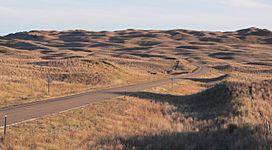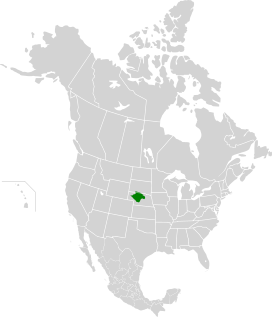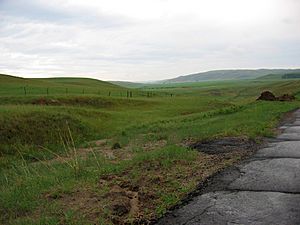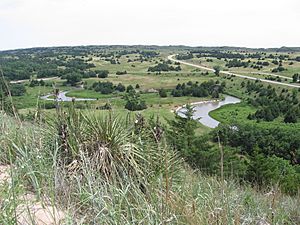Sandhills (Nebraska) facts for kids
Quick facts for kids Sandhills |
|
|---|---|

Sandhills in Hooker County, near sunset in October
|
|

The Sandhills covers portions of northern and western Nebraska.
|
|
| Area | 19,600 sq mi (51,000 km2) |
| Geography | |
| Country | United States |
| State | Nebraska |
| Region | High Plains |
| Rivers |
List
|
| Designated: | 1984 |
The Sandhills (sometimes called Sand Hills) is a special area in north-central Nebraska. It's a huge region of sandy dunes covered by mixed prairie grasses. This amazing natural area makes up more than a quarter of the entire state! In 1984, it was named a National Natural Landmark because of its unique features.
Contents
Exploring the Sandhills Geography
The exact size of the Sandhills can change depending on how it's measured. It covers about 19,600 square miles (50,760 square kilometers). Some definitions say it's even larger, up to 23,600 square miles (61,100 square kilometers).
The sand dunes here can be really tall, sometimes over 330 feet (100 meters) high! The land slowly gets higher as you go from east to west. In the east, it's about 1,800 feet (550 meters) above sea level. In the west, it reaches about 3,600 feet (1,100 meters).
Underneath the Sandhills is a giant underground water supply called the Ogallala Aquifer. Because of this, you'll find many shallow lakes and ponds in the low areas between the grassy dunes. Rivers like the Loup River and the Niobrara River flow through the eastern and central parts. The western part has many small basins where water collects and doesn't flow out to other rivers.
The World Wide Fund for Nature (WWF) sees the Sandhills as a unique ecoregion. They say that about 85% of this area is still natural habitat. This is the highest percentage in the whole Great Plains! This is mainly because people haven't plowed much of the land for crops.
Past Climate and What the Future Might Hold
Scientists study past climates to understand how the Earth has changed. They found that the Nebraska Sandhills might have had active, moving sand dunes not too long ago. This was during a time called the Medieval Warm Period. Back then, temperatures in the North Atlantic were about 1°C (1.8°F) warmer than they are now. Much of the area was like a dry, scrub desert.
Today, global warming could make the grassland climate less stable. If there are more fires, mild droughts, and erosion, the area could become more like a desert. Computer models show that the Sandhills could face very severe droughts in the future.
History of the Sandhills
For a long time, people thought the Sandhills were just a useless desert. But in the 1870s, cattle ranchers discovered they were great for raising Longhorn cattle.
The sandy soil here is very fragile, so it's not good for growing crops. People tried farming in the late 1870s and again around 1890, but it usually didn't work out.
In 1904, a law called the Kinkaid Act was passed. It let homesteaders claim 640 acres (2.6 square kilometers) of land. This was much more than the 160 acres (0.65 square kilometers) allowed by the earlier Homestead Act of 1862. Between 1910 and 1917, almost nine million acres (36,000 square kilometers) were claimed by these "Kinkaiders." Some tried to farm, but most failed. This included DeWitty, Nebraska's largest black settlement, which was in southeast Cherry County until the 1930s.
Today, the Sandhills is a very important area for raising cattle. It supports over 530,000 beef cattle! The number of people living in the region is slowly going down. Younger generations often move to cities. However, many small towns still exist in the area.

Amazing Plants and Animals
The Sandhills is the largest and most complex wetland ecosystem in the United States. It's home to a huge variety of plants and animals. Because there's been very little farming, the land hasn't been broken up into small pieces. This means animals and plants have large, continuous habitats, which helps keep the area's natural diversity strong.
The Sandhills is home to 314 different kinds of vertebrate animals. These include mule deer, white-tail deer, coyotes, red foxes, and wild turkeys. You can also find badgers, skunks, native bats, and many types of fish.
The thousands of ponds and lakes in the Sandhills help refill the Ogallala Aquifer. This aquifer then feeds creeks and rivers like the Niobrara and Loup rivers. These waters are home to many fish species. The lakes often have sandy bottoms and provide water for the region's cattle. Some lakes are alkaline (salty) and have special shrimp living in them.
Plants of the Sandhills
There are 720 different kinds of plants found in the Sandhills. Most of them are native to the area. Only about 7% are non-native, which is half the number found in most other prairie systems.
One special plant is the blowout penstemon (Penstemon haydenii). This is an endangered species found only in the Sandhills and similar places in central Wyoming. The blowout penstemon helps to hold the soil in place where wind has blown away the sand, creating a "blowout." But other plants can quickly grow over it and choke it out. Modern ranching and land management have reduced natural erosion, which means less habitat for this unique plant.
Many Sandhills plants are good at growing in sandy soil. They come from short-grass, mixed-grass, and tallgrass prairies. These plants have helped to stabilize the sand dunes, creating a healthy environment for other plants and animals. Good land management by ranchers has also helped to reduce erosion and keep the natural landscape mostly intact.
Insects of the Sandhills
Many types of insects live in the Sandhills. You can find dragonflies, grasshoppers, and mosquitos. There are also many kinds of spiders. Because there are so many lakes and wetlands, mosquito populations can grow quite large during the summer months.
Birds of the Sandhills
The Sandhills is an important stop along the Central Flyway for many migratory birds. The region's many bodies of water give them places to rest during their long journeys. Ponds and lakes are popular resting spots for cranes, geese, and many types of ducks. Some birds, like the western meadowlark (Nebraska's state bird), live in the Sandhills all year round.
Sandhills Climate
The Sandhills is considered a semi-arid region. This means it doesn't get a lot of rain. The average rainfall is about 23 inches (580 mm) in the east and less than 17 inches (430 mm) in the west. Temperatures can vary a lot, from very cold lows of -30°F (-34°C) to hot highs of 105°F (41°C).
Protecting the Sandhills
Many groups are working hard to protect the Sandhills. Here are some of the important areas and organizations:
- Valentine National Wildlife Refuge: This refuge covers about 71,516 acres (289.4 square kilometers) and is south of Valentine.
- Crescent Lake National Wildlife Refuge: Located in the central Panhandle, it covers 45,849 acres (185.5 square kilometers).
- The Nature Conservancy's Niobrara Valley Preserve: This preserve in Cherry, Brown, and Keya Paha counties covers 60,000 acres (240 square kilometers) and includes a 25-mile (40-kilometer) stretch of the Niobrara River.
- Fort Niobrara National Wildlife Refuge: Near Valentine, this refuge covers 19,000 acres (77 square kilometers).
Many organizations work together to conserve the Sandhills. These include the Institute of Agriculture and Natural Resources, the Nature Conservancy of Nebraska, the University of Nebraska, and the United States Fish and Wildlife Service.
Images for kids
-
Small ponds and lakes are common in the Sand Hills, such as this one near Antioch.




